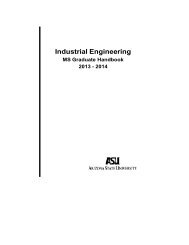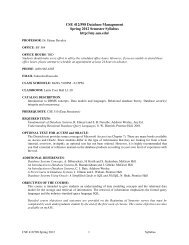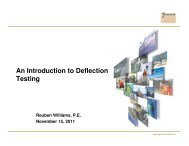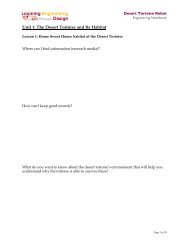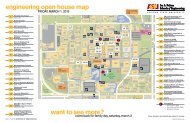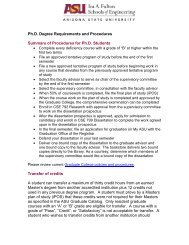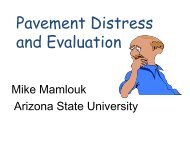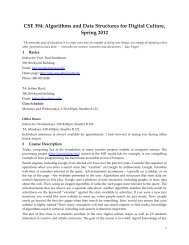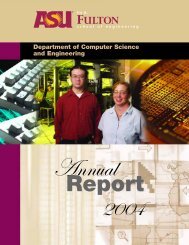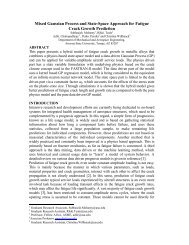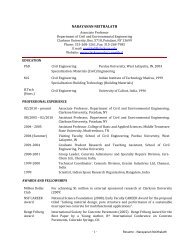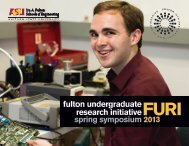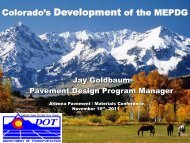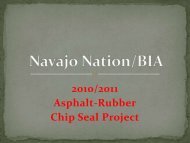Abstract Book - Ira A. Fulton Schools of Engineering - Arizona State ...
Abstract Book - Ira A. Fulton Schools of Engineering - Arizona State ...
Abstract Book - Ira A. Fulton Schools of Engineering - Arizona State ...
Create successful ePaper yourself
Turn your PDF publications into a flip-book with our unique Google optimized e-Paper software.
Aneurysm Treatment with Polymer Gels<br />
David Eaton, Bioengineering<br />
Graduation: May 2011 Hometown: Houston, Texas<br />
Mentor: Dr. Brent Vernon, Bioengineering<br />
Grand Challenge: Engineer better medicine<br />
The objective is to examine the properties <strong>of</strong> two gels to determine if they can be used to embolize brain aneurysms.<br />
For the first gel, in vitro degradation tests were done to determine how the Young’s Modulus changed over time at<br />
different temperatures and for different swelling amounts. The ultimate compressive strength was also measured<br />
for some samples. For the second gel, rheology was performed in order to determine how several variables affect<br />
the gelling reaction rate. Swine studies will have to be done on the first gel; compression and degradation studies<br />
will be done on the second gel.<br />
Analysis <strong>of</strong> Traffic Instabilities in Congested Traffic<br />
Taylor Ehrick, Civil and Environmental <strong>Engineering</strong><br />
Graduation: May 2010 Hometown: Phoenix, <strong>Arizona</strong><br />
Mentor: Dr. Soyoung Ahn, Civil, Environmental and Sustainable <strong>Engineering</strong><br />
Grand Challenge: Restore and improve urban infrastructure<br />
The objective <strong>of</strong> this research is to analyze macroscopic traffic behavior <strong>of</strong> stop-and-go driving, including its lanespecific<br />
characteristics and relation to freeway geometry. Vehicle count and speed data from <strong>State</strong> Route 99 near<br />
Sacramento, California were analyzed by taking the second-order difference <strong>of</strong> the cumulative vehicle count and<br />
speed with a moving time window to quantify the magnitude <strong>of</strong> stop-and-go oscillations. The preliminary findings<br />
indicate that stop-and-go oscillations exhibit lane-specific behavior. Further research will verify the preliminary<br />
findings at different freeway sites.<br />
Prototyping <strong>of</strong> Patient-Specific Heat Models<br />
Fariha Ejaz, Bioengineering<br />
Graduation: May 2010 Hometown: Gilbert, <strong>Arizona</strong><br />
Mentor: Dr. David Frakes, Bioengineering<br />
Grand Challenge: Advance personalized learning<br />
Current tangible models for surgical education and planning are primarily limited to generic cases that are not<br />
patient-specific. These are <strong>of</strong> limited value since every individual is different and the general models are not based<br />
on real patient data. This project is designed to address current limitations through creation <strong>of</strong> patient-specific<br />
cardiovascular models that include conventional color coding. These models will aid in surgical planning and<br />
education. Recent advancements in rapid prototyping (RP) make it possible to prototype complex geometries<br />
with embedded color-coding, which is important for this project. Ultimately, we expect that these tools will<br />
improve surgical outcomes.<br />
Spring 2010 13



